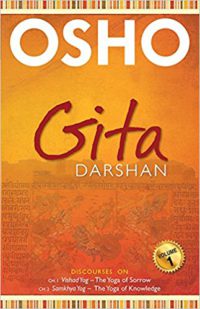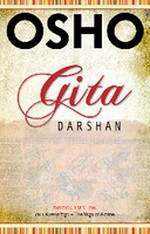Osho’s talks on Bhagavad Gita: Gita Darshan Volume I and II

“According to me, I would call Krishna ‘the father of psychology’. He is the first individual who has understood the wavering mind, the mind which is in conflict. He has seen the mind full of sorrow, the will power being fragmented – and has tried to bring integrity, unity and wholeness to the mind. He is the first individual who has introduced psychoanalysis and has explored the human mind.” Osho
Terrific Psychological Insights
“Being the father of psychology, Krishna in the Bhagavad Gita draws out of Osho many terrific psychological insights, and Osho in this book comes out as a master who hits the nail on the head mercilessly without trying to sweeten the pill.”
Osho’s toespraken over de Bhagavad Gita: Gita Darshan Volume I and II
Gita Darshan Volume I en II bieden een nieuw perspectief op de buitengewone dialogen tussen Krishna en Arjuna. Ze onthullen een onbekend aspect van Krishna’s individualiteit die veel gezichten kent. Waarschijnlijk heeft niemand voor Osho Krishna’s buitengewone inzichten zo diepgaand begrepen. Beschouwd als een goddelijke incarnatie, kan Krishna een volledige avatar genoemd worden, maar toch heeft niemand zijn genie als psycholoog tot nu toe over het voetlicht gebracht.  Osho zegt: “Wat mij betreft, wil ik Krishna ‘de vader van de psychologie’ noemen. Hij is het eerste individu die de wisselvallige mind begrepen heeft, de mind die in conflict is. Hij heeft de mind vol gekweldheid gezien, waarbij de wilskracht teniet gedaan was – en hij heeft geprobeerd om de mind tot integriteit, eenheid en heelheid te brengen. Hij is de eerste mens die de psychoanalyse geïntroduceerd heeft en de menselijke mind verkend heeft.”
Osho zegt: “Wat mij betreft, wil ik Krishna ‘de vader van de psychologie’ noemen. Hij is het eerste individu die de wisselvallige mind begrepen heeft, de mind die in conflict is. Hij heeft de mind vol gekweldheid gezien, waarbij de wilskracht teniet gedaan was – en hij heeft geprobeerd om de mind tot integriteit, eenheid en heelheid te brengen. Hij is de eerste mens die de psychoanalyse geïntroduceerd heeft en de menselijke mind verkend heeft.”
SANSKRIET ONTCIJFERD
Dankzij ma Yoga Manju die een uitgebreide kennis heeft van het Sanskriet en die als Osho’s discipel van het eerste uur gedurende een periode van meer dan 40 jaar Osho’s Hindi lezingen beluisterd heeft, zijn deze boeken in het Engels tot stand gekomen. Zij heeft geholpen om de de subtiele nuances van Osho’s oorspronkelijke Hindi talks naar voren te brengen. De fijnzinnige betekenis die door Osho in deze Hindi lezingen gelegd zijn, komen namelijk dichtbij de Sanskriet woorden.
Ons Eigen Pad Vinden
“Aan de ene kant zien we Krishna op zijn fluit spelen en dansen; daarnaast zijn onze levens gevuld met ellende en verdriet. Aan de ene kant spreekt Boeddha over de ultieme vrede, aan de andere kant zien we dat we niet eens weten wat vrede is. Aan de ene kant spreekt Christus over het koninkrijk van god, aan de andere kant zien we niets dan hel om ons heen. Ofwel zij zijn allemaal gek of wij zijn het spoor bijster geworden. Maar zij hebben het niet verkeerd: wij zijn het die verdwaald zijn. We zijn het verkeerde pad op gegaan omdat we ons eigen pad niet hebben gevonden.”
Inhoud Gita Darshan volume I en II
Osho’s talks leiden ons in Gita Darshan volume I en II door het labyrint van de menselijke mind en kunnen voor de komende generaties een methode worden die zoekers kunnen helpen. We kunnen leren om de mind en het denkproces op zo’n manier te gebruiken dat, zoals Osho ons continu in herinnering brengt. Zo kunnen gedachten ons tot de rand van de afgrond brengen waar we de uiteindelijke sprong naar gedachteloosheid kunnen maken.
Mensen dienen van mind naar no mind te gaan – dat is de reis. Maar mensen kunnen niet tot gedachteloosheid overgaan als ze niet geleerd hebben om zichzelf te begrijpen – de motieven die ze hebben, de verlangens en gehecht zijn. Osho staat een ‘psychologie van de Boeddha’s voor die de mens de juiste weg kan wijzen naar zelfontdekking en zelftransformatie.
Gita Darshan volume I en II zijn te bestellen via internet.
Impression of Gita Darshan II
The second volume of the complete talks given by Osho on the Bhagavad Gita during the early 70s in Hindi has been translated into English and published in India on May 15, 2013. It was posted as the book of the month in the April Newsletter on the website of Full Circle New Delhi.
 In this volume, Yoga of Action, Osho explains the key that unlocks the door to ‘desireless action’ – the path of Karma Yoga. What is the difference between our actions and the actions of Krishna and Osho – two great masters of the inner dimension? My actions are ‘mine’ – this seems to be the problem. We stand behind our actions with all the heavy burden of our desires and expectations. When things turn out to be the way we want, when our expectations are fulfilled, we are happy. When life does not follow our plans, we complain with god and curse the series of circumstances that prevented us from actualizing our dreams and desires. This seems to be our pattern, as human beings, for countless lifetimes, centuries and millennia – since the beginning of time.
In this volume, Yoga of Action, Osho explains the key that unlocks the door to ‘desireless action’ – the path of Karma Yoga. What is the difference between our actions and the actions of Krishna and Osho – two great masters of the inner dimension? My actions are ‘mine’ – this seems to be the problem. We stand behind our actions with all the heavy burden of our desires and expectations. When things turn out to be the way we want, when our expectations are fulfilled, we are happy. When life does not follow our plans, we complain with god and curse the series of circumstances that prevented us from actualizing our dreams and desires. This seems to be our pattern, as human beings, for countless lifetimes, centuries and millennia – since the beginning of time.
The first volume, published last year, was extremely well received in India and abroad. Chidananda and Videh are already working on the translation for volume 3 (of a total of 17 volumes) to be published next year. The Italian version will be out this September and negotiations are under way for translations into French and Spanish, to be distributed in France, Spain and South America.
You have to have a Mind before you can drop the Mind
Chidananda and Videh said, “We feel that it is a fantastic series which brings out a side of Osho that not many people have experienced, where Osho talks along the lines of ‘you have to have a mind before you can drop the mind’, and encourages the readers to search and inquire, be authentic and sincere. At times he is even ruthless in his effort to push us into self inquiry, taking the example from the dialogues between Krishna and Arjuna (Master and disciple), where Krishna pushes Arjuna hard with a pitchfork trying to make him understand – not only the dimension of the beyond, but his mental patterns that prevent him from going beyond.
Being the father of psychology, Krishna in the Bhagavad Gita draws out of Osho many terrific psychological insights, and Osho in this book comes out as a master who hits the nail on the head mercilessly without trying to sweeten the pill.”